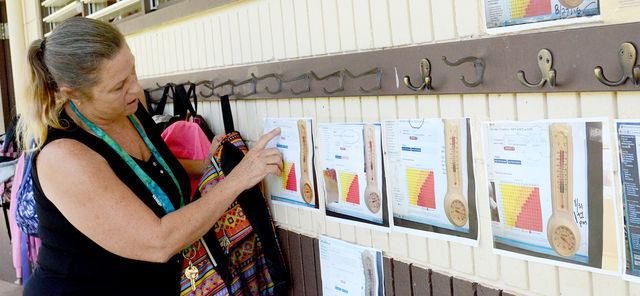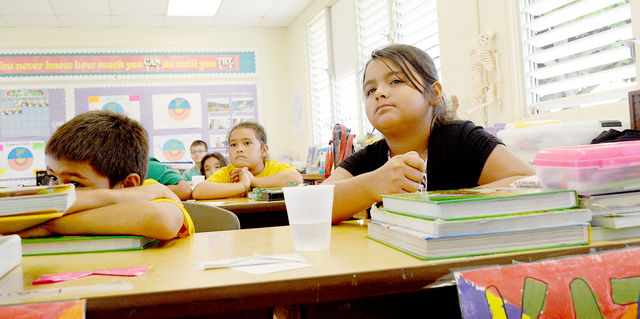KEKAHA — Students in Sue Schott’s Kekaha Elementary fourth-grade class try to stay focused on learning in a classroom where the heat index has been in the low 100s since late August. It’s difficult. “It’s really hot and it makes
KEKAHA — Students in Sue Schott’s Kekaha Elementary fourth-grade class try to stay focused on learning in a classroom where the heat index has been in the low 100s since late August.
It’s difficult.
“It’s really hot and it makes me sleepy,” said Kahea DePonte-Simpson one of Schott’s students. “When we go out during recess, I stay in the shade and draw.”
Schott said she’s been measuring the heat index in her classroom every day since August 20 and the average has been between 104 and 113 degrees. She said she’s routinely noticed several students nodding off in the afternoons.
“They’re so hot and it’s taking so much out of them, that’s why this is happening,” Schott said.
Teachers at Kekaha Elementary are using the air-conditioned library as often as they can when their own classrooms become unbearable. Sometimes, that means more than one class is in the library at a time.
“The kids would rather be there, on top of other people’s noise, then be dripping sweat,” Schott said.
The other challenge teachers are facing during the uncommonly hot weather is the need for students to have water and use the restroom.
“Kids are constantly having to get up to get water because they’re losing so much water,” Schott said. “It’s disruptive and more frequent than normal because they’re drinking more water than normal.”
While staying hydrated provides distractions in the classroom, the Department of Education, school administrators, and teachers alike stress the importance of drinking water.
“Here, on Kauai, we continue to remind our students and staff to keep hydrating,” said superintendent Bill Arakaki in an email. “Schools are using fans to assist with cooling and turning lights off when possible to help cool the classrooms.”
Arakaki said he told principals islandwide to encourage teachers to allow water bottles in class, and to fill them up as needed.
“No one is being prohibited from using the bathroom or drinking water,” said Domonic Beralas, principal at Kekaha Elementary said. “We know that dehydration can become serous.”
Beralas said the main solution is to use common sense ways of cooling down — that includes using fans, opening windows and taking kids outside for shady walks throughout the day.
“Safety is a high priority for all administration,” Beralas said. “(Staff needs to) do whatever is necessary to keep the kids safe, healthy, hydrated and comfortable in this climate.”
Air-conditioning is a solution the Department of Education is considering for schools all over Hawaii, but that’s not as easy to accomplish as it might sound.
According to a fact sheet distributed by the DOE in August, installing air-conditioning units within the schools is an expensive proposition.
“The majority of HIDOE schools are, on average, more than 50 years old,” the fact sheet said. “Their electrical systems reflect a bygone era. They weren’t designed to support today’s high level of energy demand.”
In addition to the out-of-date electrical systems in many of the schools, the fact sheet highlights the structure of the buildings themselves. Both of these would have to be updated before an air conditioning system could be very effective.
“For an AC system to cool a room, the building needs to be sealed, requiring replacement of windows and doors, among other things,” the fact sheet said.
Arakaki said parents and community members have been asking if they can donate fans and other cooling systems to classrooms, and he said there are certain types of cooling devices that will work.
“There are two forms for those who want to donate, and we have them here at the school,” Beralas said. ‘So it’s not as simple a thing as bringing in all the equipment and power it up.”
Schott, however, said she’s not so sure that acquiring cooling devices is the most sensible solution. In her opinion, rearranging the school year could be a better idea.
Currently, students start classes near the end of July and there are three breaks throughout the year — in October, over the winter, and in the spring.
“The trick is to start school after Labor Day,” Schott said. “Then kill the October break and take a few days off of Christmas and spring break.”
That would limit the amount of days students and staff have to spend in the classroom when the weather is the warmest.
“I know that this year is incredibly hot and I know (the Department of Education) is trying to come up with solutions,” Schott said, “but the kids can’t learn when it’s 113 degrees in your classroom.”
The weather isn’t expected to provide any relief until November or December.
“It’s a systemwide problem,” Beralas said. “It has to be addressed systemically and it has to be carefully thought through, not just a reaction.”



